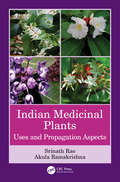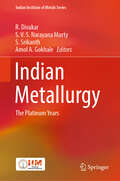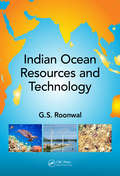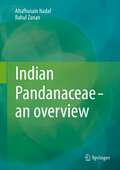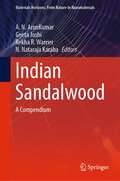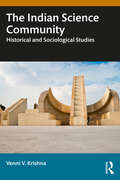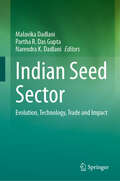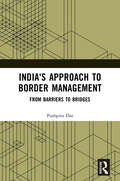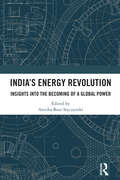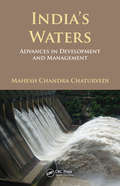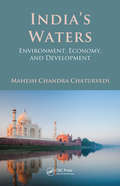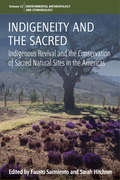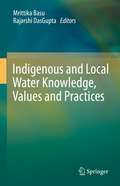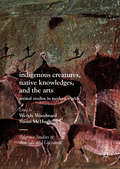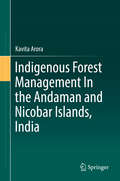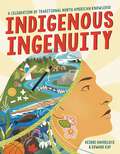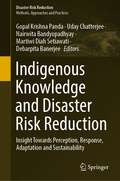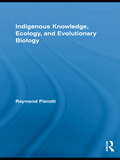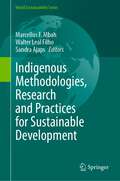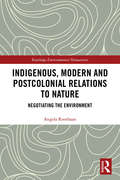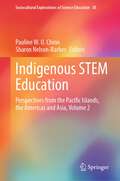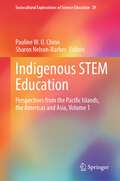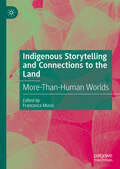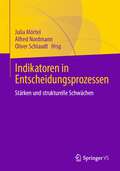- Table View
- List View
Indian Medicinal Plants: Uses and Propagation Aspects
by Srinath Rao Akula RamakrishnaThe demand for medicinal plants is increasing, and this leads to unscrupulous collection from the wild and adulteration of supplies. Providing high-quality planting material for sustainable use and thereby saving the genetic diversity of plants in the wild is important. In this regard, the methods of propagation of some important medicinal plants are provided along with the traditional methods of propagation. Indian Medicinal Plants: Uses and Propagation Aspects offers a unique compendium of more than 270 medicinal plant species from India with detailed taxonomic classifications based on the Bentham and Hooker system of classification. Salient Features: Provides traditional methods of propagation and discusses the propagation of medicinal plants Presents plant properties, plant parts and chemical constituents Describes the medicinal uses of more than 270 medicinal plant species from India This book is of special interest to practitioners of alternative medicine, students of Ayurveda, researchers and industrialists associated with medical botany, pharmacologists, sociologists and medical herbalists.
Indian Metallurgy: The Platinum Years (Indian Institute of Metals Series)
by Amol A. Gokhale R. Divakar S. V. S. Narayana Murty S. SrikanthThe book marks the Platinum Jubilee of the Indian Institute of Metals, closely matching independent India's age. It is envisaged as a compilation of technical articles tracing the birth and growth trajectory of metallurgical science, engineering and technology in the nation, attempting a degree of prognostication covering the next quarter of a century. It contains the essence of the metallurgical research and development and industrial progress India has witnessed in the last 75 years. This book comprises technical articles written by industry leaders and eminent technocrats. It includes overviews by distinguished researchers who have strived to build foundations of new metallurgical research and engineering fields. It includes learned writings of persons associated with premier institutions heavily dependent on metallurgy and materials. They have made seminal contributions by nurturing the growth of metallurgical research and industrial production or have made first-hand contributions to building the great organisations we have today. Coinciding with the Platinum Jubilee year of the Indian Institute of Metals, this book brings out the enormous efforts of these individuals representing their organisations to share insights that led to their success as an entity. Similarly, several professionals who significantly contributed to the understanding of metallurgical engineering, have held important positions and steered the national strategic programmes or academically nurtured students in their illustrious careers also share their journey in this book. This book chronicles the significant advances made in the field of metallurgical science, engineering and technology in India, presenting the historical perspective and prospects in the format of a technical volume.
Indian Ocean Resources and Technology
by Ganpat Singh RoonwalThe current scenario provides an ideal opportunity to confer higher priority to the marine resources of the Indian Ocean, particularly in terms of integrated management of the deep sea, shallow sea and coastal resources. This will maximize their potential in the sustainable development goal (SDG) pattern, leading to an appropriate environmental management. Therefore, this book aims to provide an overview of the area and to highlight the potential market opportunities represented by this vast and rapidly developing nation. In doing so the following aspects have been covered: Exclusive title focussing on mineral resources of Indian ocean. Discusses living, nonliving, ocean waves and tidal energy, ocean environment and protection aspects. Includes information on key themes, details of organizations associated with the Indian Ocean. Illustrates deep sea mining technology and environmental perspectives. Covers hydrocarbons-sub sea oil and gas, minerals from placer deposits to deep sea nodules, sea floor massive sulphides and cobalt rich encrustations.
Indian Pandanaceae - an overview
by Altafhusain Nadaf Rahul ZananIndian screw pine family Pandanaceae represents three genera, in which genus Pandanus and Benstonea are distributed in two hotspots in India - the Western Ghats and the Northeast Himalayan region. For the first time, Indian Pandanaceae has been assessed for its taxonomic status and phylogenetic relationship. The extensive survey by the authors led to the discovery of three new Pandanus species (two from the Western Ghats and one from the Northeast Himalaya). The present taxonomic revision confirmed total number of Pandanus species to 14 that are distributed in the Southern India (9 species) and Northeast Himalayan region (5 species). Genus Benstonea is represented by two species, one from Southern India and another species common to both regions. A detailed species identification key is given along with conservation status of each species following IUCN Red List Categories and Criteria (2001). The study revealed that, out of 16 Pandanus and Benstonea species, six species are under threatened categories. In recent years, a chloroplast DNA-based molecular phylogenetic approach has been followed to understand the evolutionary relationship among the plant species. The interrelationship among the 14 Pandanus species at infrageneric level has been worked out using this approach, which has led to the rearrangement of some species to the subgenera proposed by Stone (1974). Moreover, the close relationship between Pandanus and Benstonea has been confirmed and the interrelationship of Indian Pandanus genus in global context is given. This book also describes the economic importance of each Pandanus species.
Indian Sandalwood: A Compendium (Materials Horizons: From Nature to Nanomaterials)
by A. N. Arunkumar Geeta Joshi Rekha R. Warrier N. Nataraja KarabaThis book provides a global perspective of Indian Sandalwood categorized as ‘Vulnerable’ by the International Union for Conservation of Nature. It deals with history, distribution, propagation, chemistry, utilization, improvement, trade, and conservation in the present context. This book explores ways and means for restoring its past glory by creating awareness for its conservation and sustainable utilization. The content encompasses informative tables, appropriate graphs and figures, and illustrations with photographs and line drawings. This compendium would be useful for foresters, forestry professionals, botanists, policymakers, conservationists, NGOs, and researchers in the academia and the industry sectors.
The Indian Science Community: Historical and Sociological Studies
by Venni V. KrishnaThis book focuses on the historical and sociological dimensions of scientists working in laboratories in India, offering insights into the historical, sociological and policy factors that shape scientific pursuits. It illuminates the challenges, accomplishments and the evolving role of science in societal development.The author initiates a broader discourse on the interplay between scientific advancements, societal contexts and policy frameworks. The book fosters a deeper understanding of science's role in shaping India’s social fabric and contributing to the global scientific dialogue. It also explores issues such as brain drain, science activism and the conflict between university- and government-run models of science.Lucid and topical, the book will be of considerable interest to both social and natural scientists, as well as the general academic community, including research students in science, technology, history, social history of science, science and technology studies and innovation policies.
Indian Seed Sector: Evolution, Technology, Trade and Impact
by Malavika Dadlani Partha R. Das Gupta Narendra K. DadlaniThis book provides an insight into the growth of the Indian seed industry in the past 60 years. It analyzes the socio-economic parameters, complexities, diversities, and need for a strong seed system with appropriate regulatory frameworks in the Indian agrarian economy. The role of rich biological resources and development of a scientific plant breeding system, which laid the strong foundation of the seed sector is discussed. While outlining the growth of a multi-crop and multi-dimensional seed industry, this book examines the role of breeders and seed industry, and rights of farmers, changing regulatory framework governing the seed sector, and impact of inter-governmental conventions, agreements and treaties in regulating the seed sector. Role played by the public and private partners in the establishment of seed sector with science-led technologies and capacity building, and expansion of the domestic seed industry is emphasized. The impact of seed system development with limitations and future prospects is also discussed with a view of a global seed scenario. This book has a wide base of readership including seed industry professionals, policy makers, academicians, researchers and students.
Indiana Grade 7 Interactive Science
by Don Buckley Zipporah Miller Michael Padilla Kathryn ThorntonScience textbook
India's Approach to Border Management: From Barriers to Bridges
by Pushpita DasThis book attempts to provide a comprehensive understanding of the circumstances which have shaped India’s approach towards its international borders and the framework it has developed to better manage its borders. The book argues that persistence of various cross-border threats and challenges and an absence of robust intra-regional trade among its neighbouring countries forced India to employ a security-centric and unilateral approach to border management with emphasis on hardening the borders to cross-border trade and travel and keeping the border areas underdeveloped to act as a buffer against external conventional threats. Besides discussing the threats and challenges that India faces along the borders, the book aims to develop an understanding of India’s border management practices by analysing various programmes and initiatives such as the raising of border guarding forces; building of physical and electronic fences; the establishment of modern facilities for smoothening legitimate cross-border travel; the development of the border areas through special programmes; and increasing trade and connectivity as well as other cooperative bilateral mechanisms. Print edition not for sale in South Asia (India, Sri Lanka, Nepal, Bangladesh, Pakistan and Bhutan).
India’s Energy Revolution: Insights into the Becoming of a Global Power
by Annika Bose StyczynskiIndia is the third-largest emitter of greenhouse gases, which makes it an important player whose climate mitigation actions and inactions are closely scrutinised. This book studies developments in India’s energy system from a governance perspective. It presents a unique compilation and synthesis of research findings that capture achievements, shortcomings, and persistent and transient challenges of India’s transition towards a net-zero economy by 2070.The book grounds its analysis in domestically formulated goals and reflects on dynamics at the structural level of India’s multi-scalar innovation system, by highlighting the influencing factors of energy system status and change. It presents the perspectives and positions of different actor groups, studies the market and business, and discusses cases influenced by existing or changing institutions across the whole spectrum of energy resources from fossil to non-fossil fuels and respective technologies.The volume will be useful for students and researchers in energy governance, energy policy and economics, socio-technical transition studies, energy systems engineering, sustainable development, and environmental studies. It will also be of interest to policymakers and investors.
India's Waters: Advances in Development and Management
by Mahesh Chandra ChaturvediIndia's Waters: Advances in Development and Management is a critical study of the development and management of India's waters. Its central theme is that the current methods in use are an extension of the colonial-era system, which, despite vast growth, has remained essentially the same in terms of developmental concepts, technological activities,
India's Waters: Environment, Economy, and Development
by Mahesh Chandra ChaturvediRegulation of India's rivers and other water systems has been evolving for thousands of years in the face of varying socioeconomic and technological conditions. India's Waters: Environment, Economy, and Development is a study of the current state of development, and proposed future development policies of the government of India, which is the devel
Indigeneity and the Sacred: Indigenous Revival and the Conservation of Sacred Natural Sites in the Americas (Environmental Anthropology and Ethnobiology #22)
by Fausto Sarmiento Sarah HitchnerThis book presents current research in the political ecology of indigenous revival and its role in nature conservation in critical areas in the Americas. An important contribution to evolving studies on conservation of sacred natural sites (SNS), the book elucidates the complexity of development scenarios within cultural landscapes related to the appropriation of religion, environmental change in indigenous territories, and new conservation management approaches. Indigeneity and the Sacred explores how these struggles for land, rights, and political power are embedded within physical landscapes, and how indigenous identity is reconstituted as globalizing forces simultaneously threaten and promote the notion of indigeneity.
Indigenous and Local Water Knowledge, Values and Practices
by Mrittika Basu Rajarshi DasGuptaThis book provides a knowledge base of the existing indigenous and local water knowledge, values, and practices, and how this water knowledge can be mainstreamed into the decision-making process. The book not only demonstrates the perks of using indigenous knowledge but also illustrates the barriers and gaps that should be considered while planning for mainstreaming traditional knowledge and values at a local scale. The chapters incorporate case studies from various parts of the world demonstrating how indigenous, and religious and cultural values of water have translated into water use and conservation behavior among indigenous people ensuring resource sustainability over a long period of time. There has been global attention towards combining indigenous and local knowledge with new information and innovation to attain future water security. In this regard, this book is timely, relevant, and significant as it is the first attempt, as per the best of our knowledge, to publish a book that solely addresses indigenous and local knowledge, values, and practices regarding water management, quality monitoring, use, and conservation. With increasing emphasis on the inclusion of indigenous and local knowledge into natural resource governance and conservation by international agencies like the Intergovernmental Science-Policy Platform on Biodiversity and Ecosystem Services (IPBES), the proposed book will significantly contribute to the existing knowledge base and demonstrate the importance of mainstreaming indigenous water knowledge and practices into water governance and decision making. The UN SDGs, recognizing the significance of indigenous knowledge systems, emphasized its inclusion in most aspects and principles of SDGs. Apart from direct links with SDGs like zero hunger (SDG 2), no poverty (SDG 1), and climate action (SDG 13), indigenous and local knowledge system is considered to be directly connected to clean water and sanitation (SDG 6). The book will be useful to researchers and students in the field of indigenous knowledge and education, water governance, community-level planning, and water sustainability. The book can be referred to for postgraduate courses and beyond, as well as policymakers, conservationists, non-governmental organizations, development practitioners, and local government officials.
Indigenous Creatures, Native Knowledges, and the Arts
by Wendy Woodward Susan MchughThis volume illuminates how creative representations remain sites of ongoing struggles to engage with animals in indigenous epistemologies. Traditionally imagined in relation to spiritual realms and the occult, animals have always been more than primitive symbols of human relations. Whether as animist gods, familiars, conduits to ancestors, totems, talismans, or co-creators of multispecies cosmologies, animals act as vital players in the lives of cultures. From early days in colonial contact zones through contemporary expressions in art, film, and literature, the volume's unique emphasis on Southern Africa and North America - historical loci of the greatest ranges of species and linguistic diversity - help to situate how indigenous knowledges of human-animal relations are being adapted to modern conditions of life shared across species lines.
Indigenous Forest Management In the Andaman and Nicobar Islands, India
by Kavita AroraThis book offers an extensive study of indigenous communities in the Andaman and Nicobar Islands, India, and their methods of forest conservation, along with an exploration of the impact of forestry operations in the islands and the wide scale damage they have incurred on both the land and the people. Through an in-depth analysis of the contrasting indigenous practices and governmental forestry schemes, the author has compared the modern ‘Joint Forest Management’ resolution with the ethos and practices of the indigenous people of the Andaman and Nicobar Islands. Throughout the book, readers will learn about the different indigenous communities inhabiting these islands and the treasure of knowledge each of them provide on forest conservation. The book establishes that the notion of knowledge is politicized by the dominant culture in the context of Andaman’s forest tribes, and traces how this denial of the existence of indigenous knowledge by government officials has led to reduced forest area in the region. The book also explores and analyses strategies to utilize and conserve the tribes' profound knowledge of the biodiversity of the islands and study their efforts towards forest conservation, protection and rejuvenation.
Indigenous Ingenuity: A Celebration of Traditional North American Knowledge
by Edward Kay Deidre HavrelockCelebrate Indigenous thinkers and inventions with this beautifully designed, award-winning interactive nonfiction book—perfect for fans of Braiding Sweetgrass. <P><P>Corn. Chocolate. Fishing hooks. Boats that float. Insulated double-walled construction. Recorded history and folklore. Life-saving disinfectant. Forest fire management. Our lives would be unrecognizable without these, and countless other, scientific discoveries and technological inventions from Indigenous North Americans. Spanning topics from transportation to civil engineering, hunting technologies, astronomy, brain surgery, architecture, and agriculture, Indigenous Ingenuity is a wide-ranging STEM offering that answers the call for Indigenous nonfiction by reappropriating hidden history. <P><P>The book includes fun, simple activities and experiments that kids can do to better understand and enjoy the principles used by Indigenous inventors. Readers of all ages are invited to celebrate traditional North American Indigenous innovation, and to embrace the mindset of reciprocity, environmental responsibility, and the interconnectedness of all life.
Indigenous Knowledge and Disaster Risk Reduction: Insight Towards Perception, Response, Adaptation and Sustainability (Disaster Risk Reduction)
by Gopal Krishna Panda Uday Chatterjee Nairwita Bandyopadhyay Martiwi Diah Setiawati Debarpita BanerjeeThe book seeks to comprehend how indigenous knowledge systems of local communities can be effectively used in disaster management of various types. A prime example is the 2015 Sendai Framework for Disaster Risk Reduction, promoting indigenous environmental management knowledge and practices. Traditional knowledge of indigenous peoples includes information and insight that supplement conventional science and environmental observations, a comprehensive understanding of the environment, natural resources, culture, and human interactions with them which is not documented before. A great deal of this knowledge have been lost in translation. In this book, the authors attempt to keep a record of each and every traditional knowledge study of the indigenous communities in managing the disasters. The use of indigenous knowledge systems in disaster understanding and management is the primary focus of the chapters. This book is organized into four major sections. The first part gives an overview and help in conceptualizing the different concepts of hazard and disaster perception and how response and adaptation are connected with it. This part also discusses the concept of the connection between hazard and sustainable development and how the understanding of risk reduction and resilience can happen with the help of indigenous knowledge, insights, and strategies. The second part of the book introduces the different approaches to disaster and risk management. It establishes how vulnerability influences the risk associated with a hazard and the responses can be both positive and negative in disaster management. The approaches of the indigenous communities in managing a disaster, their resilience, capacity building, and community-based preparedness will be the area of prime focus in this chapter. Part 3 of this book describes the concept of sustainability through indigenous knowledge and practice. The sole highlight of this chapter is the indigenous knowledge efficacies in disaster identification, risk reduction, climate risk management, and climate action. The last section of the book explores how to meet the gaps between local knowledge and policy formulation. It highlights how traditional knowledge of the indigenous communities can prove to be beneficial in developing a holistic regional-based policy framework which will be easily accepted by the target stakeholders since they will be more acquainted with the local strategies and methods. This section ends with an assessment and discussion of the gaps and future scopes in disaster risk reduction through integrating local knowledge and modern technologies.
Indigenous Knowledge, Ecology, and Evolutionary Biology: Indigenous Knowledge, Ecology, And Evolutionary Biology (Indigenous Peoples and Politics)
by Raymond PierottiIndigenous ways of understanding and interacting with the natural world are characterized as Traditional Ecological Knowledge (TEK), which derives from emphasizing relationships and connections among species. This book examines TEK and its strengths in relation to Western ecological knowledge and evolutionary philosophy. Pierotti takes a look at the scientific basis of this approach, focusing on different concepts of communities and connections among living entities, the importance of understanding the meaning of relatedness in both spiritual and biological creation, and a careful comparison with evolutionary ecology. The text examines the themes and principles informing this knowledge, and offers a look at the complexities of conducting research from an indigenous perspective.
Indigenous Methodologies, Research and Practices for Sustainable Development (World Sustainability Series)
by Marcellus F. Mbah Walter Leal Filho Sandra AjapsThis book states that whilst academic research has long been grounded on the idea of western or scientific epistemologies, this often does not capture the uniqueness of Indigenous contexts, and particularly as it relates to the achievement of the United Nations Sustainable Development Goals (SDGs). The SDGs were announced in 2015, accompanied by 17 goals and 169 targets. These goals are the means through which Agenda 2030 for sustainable development is to be pursued and realised over the next 15 years, and the contributions of Indigenous peoples are essential to achieving these goals.Indigenous peoples can be found in practically every region of the world, living on ancestral homelands in major cities, rainforests, mountain regions, desert plains, the arctic, and small Pacific Islands. Their languages, knowledges, and values are rooted in the landscapes and natural resources within their territories.However, many Indigenous peoples are now minorities within their homelands and globally, and there is a dearth of research based on Indigenous epistemologies and methodologies. Furthermore, academic research on Indigenous peoples is typically based on western lenses. Thus, the paucity of Indigenous methodologies within mainstream research discourses present challenges for implementing practical research designs and interpretations that can address epistemological distinctiveness within Indigenous communities.There is therefore the need to articulate, as well as bring to the nexus of research aimed at fostering sustainable development, a decolonising perspective in research design and practice.This is what this book wants to achieve. The contributions critically reflect on Indigenous approaches to research design and implementation, towards achieving the sustainable development goals, as well as the associated challenges and opportunities. The contributions also advanced knowledge, theory, and practice of Indigenous methodologies for sustainable development.
Indigenous, Modern and Postcolonial Relations to Nature: Negotiating the Environment (Routledge Environmental Humanities)
by Angela RoothaanIndigenous, Modern and Postcolonial Relations to Nature contributes to the young field of intercultural philosophy by introducing the perspective of critical and postcolonial thinkers who have focused on systematic racism, power relations and the intersection of cultural identity and political struggle. Angela Roothaan discusses how initiatives to tackle environmental problems cross-nationally are often challenged by economic growth processes in postcolonial nations and further complicated by fights for land rights and self-determination of indigenous peoples. For these peoples, survival requires countering the scramble for resources and clashing with environmental organizations that aim to bring their lands under their own control. The author explores the epistemological and ontological clashes behind these problems. This volume brings more awareness of what structurally obstructs open exchange in philosophy world-wide, and shows that with respect to nature, we should first negotiate what the environment is to us humans, beyond cultural differences. It demonstrates how a globalizing philosophical discourse can fully include epistemological claims of spirit ontologies, while critically investigating the exclusive claim to knowledge of modern science and philosophy. This book will be of great interest to students and scholars of environmental philosophy, cultural anthropology, intercultural philosophy and postcolonial and critical theory.
Indigenous STEM Education: Perspectives from the Pacific Islands, the Americas and Asia, Volume 2 (Sociocultural Explorations of Science Education #30)
by Pauline W. U. Chinn Sharon Nelson-BarberThis book builds upon the range of Indigenous theory and research found in Volume I and applies these learnings to interventions in schools, communities, teacher education and professional development. It is part of a two-volume set addresses a growing recognition that interdisciplinary, cross-cultural and cross-hybrid learning is needed to foster scientific and cultural understandings and move STEM learning toward more just and sustainable futures for all learners. Authors working in Eurocentric settings of schools and colleges—whether in the continental or island United States, Canada, Thailand, Taiwan or Chuuk—utilize storytelling, place, language and experiential learning to engage students in meaningful, highly contextualized study that honors ancestral knowledge and practices. They recognize that their disciplines have been structured and colonized by Eurocentric/American frameworks that lack storied, ethical contexts developed through living sustainably in particular places. Recognizing that students seeking to enter STEM majors and careers now must be knowledgeable in multiple ways, authors describe innovative ways to immerse precollege learners as well as developing and practicing teachers in settings that intersect culture, place, heritage language, and praxis that enable Indigenous and local knowledge to become central to learning. Twenty-first century technologies of distance learning, digital story-telling, and mapping technologies now enable formerly marginalized, minoritized groups to share their worldviews and systems of knowledge.
Indigenous STEM Education: Perspectives from the Pacific Islands, the Americas and Asia, Volume 1 (Sociocultural Explorations of Science Education #29)
by Pauline W. U. Chinn Sharon Nelson-BarberThis book explores ways in which systems of local knowledge, culture, language, and place are foundational for STEM learning in Indigenous communities. It is part of a two-volume set that addresses a growing recognition that interdisciplinary, cross-cultural and cross-hybrid learning is needed to foster scientific and cultural understandings and move STEM learning toward more just and sustainable futures for all learners. Themes of learning from elders, through practice and place-based experiences are found across cultures. Each chapter brings a uniquely Indigenous point of view to the educational transformation efforts taking place in these distinct contexts. In the second section the chapters use authentic research stories to explain many ways in which regular disciplinary policies and practices can impact Indigenous students’ participation in STEM classrooms and careers. These authors go on to discuss ways to engage learners in STEM activities that are interconnected with the contexts of their lives.
Indigenous Storytelling and Connections to the Land: More-Than-Human Worlds
by Francesca MussiThis book builds on the perspective that, for Indigenous peoples, relations to the land are familial, intimate, intergenerational, spiritual, instructive, and life nourishing, and it is these relations that Western societies sought to destroy as part of their colonial projects of territorial conquest and exploitation of resources. Positioning storytelling as a research methodology and a model of decolonial practice, this edited collection seeks to explore the following key questions: how does Indigenous storytelling contribute to understanding Indigenous identity and the crucial role of the land in Indigenous ways of life? How can Indigenous storytelling subvert colonial narratives of the land? How can Indigenous storytelling contribute to addressing colonial exploitations of the land and its resources? Can Indigenous storytelling become a rich mode for the investigation of current climate crises? And, finally, how does storytelling assist Indigenous peoples in restoring their intimate relations to the land and its natural gifts? Through critical analysis of a unique range of Indigenous storytelling practices, including fiction, performative art, new media platforms, archaeological findings and personal live-experienced stories, this collection aims to examine the interplay between colonialism and current environmental challenges, and to expose the impacts – past, present, and future – of Western worldviews on Indigenous connections to the land, whilst simultaneously bringing to the fore Indigenous ethos of care and land custodianship.
Indikatoren in Entscheidungsprozessen: Stärken und strukturelle Schwächen
by Julia Mörtel Alfred Nordmann Oliver SchlaudtIndikatoren sind in Prozessen des Monitorings in allen gesellschaftlich relevanten Bereichen sowie in Prozessen der wirtschaftlichen und politischen Entscheidungsfindung von der lokalen Ebene bis zur internationalen Governance unverzichtbar geworden. Überall in der öffentlichen und medialen Kommunikation begegnen sie uns und rechtfertigen die Wahl zwischen unterschiedlichen Optionen. Doch was zeigen uns diese Indikatoren eigentlich genau an, worin beruht ihre Relevanz, was sind ihre Stärken, was aber auch ihre prinzipiellen Grenzen? Können sie die Komplexität einzelner Sachverhalte wirklich auf das Relevante reduzieren – oder verkomplizieren sie Probleme noch weiter? Stellen sie unsere Entscheidungen auf sichere Füße – oder wiegen sie uns lediglich in der Illusion von Objektivität?Das Buch leuchtet in kurzen Fallstudien die jeweiligen Grundlagen der Erstellung von Indikatoren, aber auch ihrer Verwendung und der Ergebnisinterpretation aus und betont Leistungen, aber auch Fallstricke und Fehlannahmen. Zudem versucht es zur besseren Orientierung auf diesem unübersichtlichen Gebiet auf möglichst verbindliche Weise in das verwendete Fachvokabular einzuführen.
